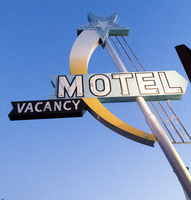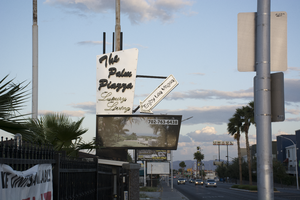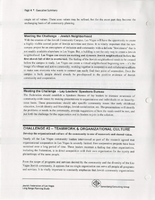Search the Special Collections and Archives Portal
Search Results

Photographs of Star Motel sign, Las Vegas (Nev.), March 3, 2017
Date
Archival Collection
Description
Site address: 1418 S 3rd St
Sign owner: M V Star Group LLC
Sign details: 0.33 acre lot, originally constructed in 1947.
Sign condition: 4 - The sign is in excellent condition, but it does not light up at night.
Sign form: Pole sign
Sign-specific description: The sign itself is attached to a silver pole that extends out toward 3 rd St and is planted into the ground. On the top of the pole is a bright, blue star with a smaller white star in the center. The neon tubes attached to the sign are in concentric star shapes radiating out from the center. Extending out from the star to 3 rd st and curving back towards the pole that hold the sign is a trail implying that this is a shooting star. The first third of this trail is white and then the paint changes to yellow and remains yellow for the rest of the trail. The entire trail of the star is covered with yellow incandescent light bulbs. There are three very thin steel poles on the opposite side of the star from where the trail is attached. These smaller poles run parallel to the main pole of the sign and end about the same place where the tail of the star ends at the other side of the pole. Attached to these thin poles are stars ranging in size and made out of neon tubes. About at the midpoint of the main pole supporting the sign is a minimal, bright blue arrow that has "MOTEL" painted on it in bold white letters with a black outline. Neon tubes in the shape of each letter are attached to the center of the letters. Attached to the bottom of the tail end of this arrow is a smaller, minimal, black arrow that has "VACANCY" painted on it in bold white letters. Neon tubes in the shape of these letters fill this sign as well.
Sign - type of display: Neon and Incandescent
Sign - media: Steel
Sign animation: Unknown, as it no longer lights. However according to RoadArch.com, at one time it might have flashed.
Sign environment: The property is in the heart of the Arts District. It resides next to many other small motels in this neighborhood. It is only a few blocks away from Main Street and Charleston where there are many art galleries, restaurants, and vintage boutiques.
Sign - date of installation: c. 1950s
Sign - date of redesign/move: Based on earlier photographs from the 1950's, the sign's main star that is blue with a smaller white star in the center was originally all white. Also, the white and yellow trail it leaves behind was initially all yellow as well. It is also believed that there were more stars attached to the metal bars that extend from the blue and white star and that they would have flashed.
Sign - thematic influences: A popular theme for properties during this time was the Space Age and this is sign is an example of that influential theme.
Sign - artistic significance: This sign shows an influence of the Space Age that was going on during the late 50's. Many motel signs in the city evoked the theme for the property and this sign does so for the Star Motel.
Survey - research locations: Assessor's website, Vintage Vegas, www.roadarch.com
Surveyor: Lauren Vaccaro
Survey - date completed: 2017-08-21
Sign keywords: Neon; Incandescent; Steel; Pole sign
Mixed Content

Photographs of The Palm Piazza sign, Las Vegas (Nev.), April 18, 2017
Date
Archival Collection
Description
Site address: 1919 Fremont St
Sign owner: Zen Real Estate Holding
Sign details: This building dates back to 1936 and was made for commercial living accommodations/ deluxe motel. Previous to the Palm Piazza opening this location was called the Ariza Motel which was abandoned for a few years. Kamran Foulad in 2013 purchased this building to renovate it in an effort to revitalize downtown. The Palm Piazza opened as an apartment complex in late 2013.
Sign condition: 4- slight fading but still in good condition
Sign form: Pylon
Sign-specific description: There is a black base of the sign that is not very tall which holds a back lit plastic sign that has an image of a lady under a palm-tree leaf canopy and the location's phone number in black numbers. Above this is a blue steel backing that in the shape of a sideways trapezoid which is about half of the width of the black sign beneath it (and is laid on the building side of the sign). This portion has black back lit plastic letters that spell out "The Palm Piazza" in a bubbly cursive font towards the top of the sign. Then below this in yellow skeletal neon tubes they have "Luxury Living" spelled out in a thin tight cursive font. On the road side of the sign there is an arrow blue steel arrow that points down towards the black portion of the sign. The arrow is outlined in yellow neon tubes and has "Enjoy Las Vegas" in clear print font skeletal neon tubes.
Sign - type of display: Neon and back lit plastic signs
Sign - media: Steel and plastic
Sign - non-neon treatments: Plastic portion of the sign
Sign environment: This area is located East Fremont close to Bruce Street. There are other motels surrounding this area.
Sign - date of installation: This sign has been up in form that we see today in 2013, though it looks as though they re-purposed/redesigned the sign that the Ariza Motel (previous property name) had. The previous sign has been up since at least 2007.
Sign - date of redesign/move: 2013- Ariza Motel blade taken down and the rest of the sign redesigned for the Palm Piazza.
Sign - thematic influences: Previous to the apartment complex it was a motel and their signs still has remnants of that 1950/60's motel sign design particularly with the arrow.
Survey - research locations: Assessor's Page, Review Journal article discussing the renovation of the building https://www.reviewjournal.com/local/local-las-vegas/developer-eyeing-overlooked-las-vegas-downtown-area-gets-city-boost/, Google map sattelite/ roadside view
Survey - research notes: On the top portion of the blue steel sign there are 3 short black steel beams coming out of it which used to hold an old MOTEL blade sign which was taken down around 2013.
Surveyor: Emily Fellmer
Survey - date completed: 2017-09-09
Sign keywords: Neon; Backlit; Plastic; Steel; Pole sign
Mixed Content

Pablo Macias oral history interview: transcript
Date
Archival Collection
Description
Oral history interview with Pablo Macias conducted by Elsa Lopez, Monserrath Hernandez, and Claytee D. White on December 07, 2019 for the Latinx Voices of Southern Nevada Oral History Project. Pablo Macias was rasied in the small town of Carlin outside of Elko, Nevada. His father and mother met in Ogden, Utah where his father was working on railroad in Nevada and Utah. After finishing high school, he got a job at Elko Blacksmith Shop, where he learned to weld. After attending Northern Nevada Community College, he enrolled and graduated from UNR. After graduation, he took a position at Von Tobel Middle School in 1990 teaching Spanish and Physical Education. While working as a Spanish teacher in Rancho High School he enrolled in a Master's program at Nova Southeastern University, completing the program in education administration. He currently serves as the Associate Director of Corporate Work Study Program Operations for Cristo Rey St. Viator College Preparatory High School. Subjects discussed include: Education, Rancho High School, Von Tobel Middle School, Barrick Mining, and Cristo Rey.
Text

Jewish Federation of Las Vegas long-range planning study, 2000
Date
Archival Collection
Description
Long-range planning study conducted and prepared by the Levenberg Consulting Group regarding the Jewish community of Las Vegas with particular attention to Jewish elderly, the economically disadvantaged, young adults, and Jewish education at all ages.
Text

Transcript of interview with Arby Hambric by Claytee D. White, September 23, 2015
Date
Archival Collection
Description
Arby L. Hambric's book entitled, "To Thee I See: From picking in the fields of Texas to cooking for dignitaries on U.S. Navy ships, a journey I wouldn't change," describes his profound journey from working in the cotton fields as a child to being drafted into the U.S. Navy, before completing high school. During this interview, he recalls the significant achievements of the "Red Tails" and the Tuskegee Airmen. Beginning his 20 year Navy career before military integration, Arby describes the racial tensions that plagued the U.S. Navy in the 1940s, and discusses how he was able to successfully navigate that racist environment for two decades and three war eras. Arby enrolled in San Diego State College after leaving the U.S. Navy. He also worked as maintenance personnel for Sears and Roebuck and started a catering business with his wife. He became a member of the Southern Nevada Enterprise Community, SNEC Board upon moving to Las Vegas, Nevada, after his wife died. With a family legacy he can be proud of, Arby highlights the achievements of his great grandson Taquan Mizzell, a Virginia Cavaliers running back at the University of Virginia. As a Navy veteran, Arby often volunteered his time and resources to help others in need. He recalls driving the sick and elderly back and forth from the Westside community to Valley Hospital or University Medical Center, UMC. He also discusses government enforced road closures and a wall that was built to block Blacks from entering the new downtown. This interview sheds new light on military integration and offers key strategies for overcoming environmental racism. Arby mentions a documentary about the closing of the wall and offers his predictions on the future of the Westside.
Text
International Association of Gaming Attorneys Collection
Identifier
Abstract
The International Association of Gaming Attorneys (IAGA) collection is comprised of materials collected from various corporations and casinos in Nevada and New Jersey, ranging from 1977 to 1986. There are a wide array of documents including: gaming license applications from corporations in Nevada and New Jersey, copies of casino control acts from New Jersey, gaming publications, gaming-conference proceedings, gaming commission reports, newsletters and correspondence of the National Association of Gaming Attorneys (NAGA).
Archival Collection
Irma McGonagill Photograph Collection
Identifier
Abstract
The Irma McGonagill Photograph Collection (1870-1925) consists of thirty black-and-white photographic prints, ten postcards, and fourteen photographic negatives showing Irma McGonagill and her family in Tonopah, Nevada during the mining boom. The images depict the town of Tonopah, mines around the Tonopah area, homes in Tonopah, and the McGonagill family.
Archival Collection
John Janney Photograph Collection on Pioche, Nevada
Identifier
Abstract
The John Janney Photograph Collection on Pioche, Nevada contains photographs of mining operations and townspeople in Pioche, Nevada from 1908 to 1934. The photographs are primarily panoramic views of the town, mines, and landscape around Pioche, where Janney was president of Pioche Mines Consolidated until his death in 1967. The photographs also depict the baseball field in Pioche, a train crossing the desert in Lincoln County, and the Lee Family.
Archival Collection
UNLV Libraries Collection of Lady Luck Gaming Corporation Promotional Materials and Reports
Identifier
Abstract
The UNLV Libraries Collection of Lady Luck Gaming Corporation Promotional Materials and Reports includes annual reports, financial reports, press kits, press releases, and promotional materials for the Lady Luck Gaming Corporation in Nevada, Colorado, Iowa, Mississippi, and Missouri, dating from 1993-1995.
Archival Collection
Russ Freeman Television Music Manuscripts
Identifier
Abstract
The Russ Freeman Television Music Manuscripts contains music manuscripts and production materials from Russ Freeman's work on various television specials, dating from 1969 to 1977. The collection includes music scores for television soundtracks including
Archival Collection
